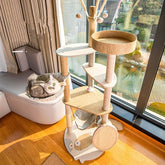The Heartwarming Tale of Ruben: A Stray Cat's Unique Journey and the Bond with His Human Friends
Table of Contents
- Key Highlights:
- Introduction
- The Life of Ruben: A Stray with a Routine
- The Ethics of Allowing Cats to Roam
- The Stray Cat Phenomenon in America
- Lessons Learned from Ruben
- FAQ
Key Highlights:
- Ruben, a stray cat in Illinois, has formed a unique bond with a family, visiting them daily for over a decade.
- The story has gained viral attention on TikTok, sparking discussions about the ethics of allowing cats to roam freely.
- Ruben's life serves as a reminder of the simple joys of companionship and the lessons pets can teach us about patience and love.
Introduction
In the realm of viral internet stories, few capture the hearts of viewers quite like that of Ruben, a stray cat who has made an indelible mark on the lives of a family in Illinois. For over a decade, Ruben has visited the same household, forging a connection that transcends the typical human-animal relationship. This story not only highlights the bond that can form between humans and unowned animals but also opens the door to broader discussions about pet ownership, freedom, and the impact of social media on our perception of these relationships. As Ruben continues to enchant those who come across his tale, we delve deeper into his life and explore the implications of such unique interactions.
The Life of Ruben: A Stray with a Routine
Ruben's story began over ten years ago, a testament to the enduring nature of feline independence. His daily visits to the family house started when Sky Bruns met him while staying at her boyfriend's residence. The cat, who has since become a beloved figure in their lives, exhibits a fascinating mix of wildness and affection. Despite never stepping inside the home, Ruben has claimed a space in the hearts of the family and visitors alike.
Sky recalls her initial encounter with Ruben, describing him as "the sweetest" from the very first moment. Her decision to share his story on TikTok under the handle @skydawne was inspired by the bond they developed over the week she spent there. In her viral post, she detailed the peculiar yet endearing habits of Ruben, such as his insistence on snacks and his penchant for lounging outside, even in the cold.
The Daily Rituals of a Stray Cat
Ruben’s routine is both charming and relatable. Each day, he arrives at the family home, often expected by all. He hunts birds and mice in the surrounding area, but his true motivation lies in the companionship and nourishment provided by his adoptive family. The cat’s vocalizations, especially when demanding his snacks, have become a familiar sound in the household.
Sky notes that although Ruben enjoys his time outside, he also seeks warmth and comfort during colder seasons. His infrequent visits to the heated house reveal a cat that, while wild at heart, appreciates the care and affection offered by the family. This unique setup has led to a symbiotic relationship; the family provides sustenance and warmth, while Ruben brings joy and a sense of community.
The Ethics of Allowing Cats to Roam
Ruben's story has sparked significant debate online, particularly concerning the ethics of allowing cats to roam outdoors. The TikTok video, which amassed over 2.1 million views, generated a wide array of opinions. Some viewers expressed concern that Ruben’s hunting habits pose a threat to local wildlife, arguing that allowing cats to roam free is irresponsible and harmful to ecosystems.
Conversely, many defended the practice, citing the natural instincts of cats and the importance of allowing them to express their inherent behaviors. One user pointed out that forcing older cats indoors can be detrimental to their well-being, advocating for a balanced approach to pet ownership that respects the animal's needs.
The Wildlife Debate
This ongoing discourse about cats and wildlife is not new. Studies have shown that unowned cats can significantly impact bird populations and other small animals. The American Bird Conservancy, for example, has emphasized the need for responsible pet ownership and the importance of keeping cats indoors or in controlled environments to safeguard local wildlife.
However, advocates for outdoor cats argue that many European countries have successfully integrated free-roaming cats into their ecosystems without significant adverse effects. They point to the cultural differences in pet ownership and the varied relationships between humans and animals around the world. This debate ultimately highlights the need for tailored solutions that consider both animal welfare and environmental conservation.
The Stray Cat Phenomenon in America
Ruben's story is not an isolated incident. The American landscape is dotted with millions of stray and unowned cats—estimates suggest there are between 30 to 80 million across the nation. These cats often form bonds with human communities, much like Ruben has done.
Unowned Cats: A National Dilemma
The existence of unowned cats poses significant challenges, from overpopulation to public health concerns. Animal welfare organizations work tirelessly to address these issues through initiatives like Trap-Neuter-Return (TNR) programs, which aim to stabilize feral cat populations while allowing them to live out their lives in familiar territories.
Ruben's ongoing relationship with his adoptive family exemplifies the potential for positive interactions between humans and stray animals. It showcases how community members can contribute to the well-being of these animals while navigating the complexities of pet ownership and environmental stewardship.
Lessons Learned from Ruben
Beyond the debates surrounding wildlife and ethics, Ruben's life offers lessons in patience, acceptance, and love. Sky Bruns reflects on how Ruben has taught her to slow down and appreciate life's simple pleasures. This sentiment resonates deeply with many pet owners who find solace and joy in their relationships with animals.
The Value of Companionship
Ruben's ability to bond with the family without being a traditional pet speaks volumes about the nature of companionship. Pets, whether owned or unowned, can enrich our lives and teach us valuable lessons about trust, loyalty, and the importance of nurturing relationships. Ruben's story encourages us to foster connections with the animals around us, even when they do not fit the conventional mold of pet ownership.
FAQ
Q1: How can I help stray cats in my area?
A1: You can assist stray cats by providing food, water, and shelter. Consider contacting local animal shelters or rescue organizations to learn about TNR programs that help manage feral populations humanely.
Q2: Is it safe to let my cat roam outside?
A2: While many cats enjoy being outdoors, there are risks involved, such as traffic, predators, and exposure to diseases. Consider creating a safe outdoor space, like a catio, or supervising your cat during outdoor time.
Q3: What should I do if I find a stray cat?
A3: If you come across a stray cat, check for identification tags. If none are present, consider taking the cat to a local veterinarian or animal shelter to check for a microchip and assess its health.
Q4: Are there any benefits to allowing cats to roam?
A4: Allowing cats to roam can provide them with exercise, mental stimulation, and the opportunity to engage in natural behaviors. However, it's essential to balance these benefits with the potential risks to wildlife and the cat's safety.
Q5: How can I advocate for responsible pet ownership?
A5: You can advocate for responsible pet ownership by educating others about the importance of spaying/neutering, keeping cats indoors, and supporting local animal welfare organizations that promote humane treatment of animals.





